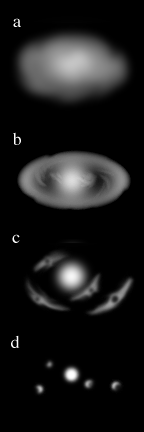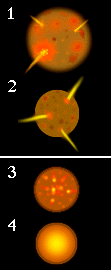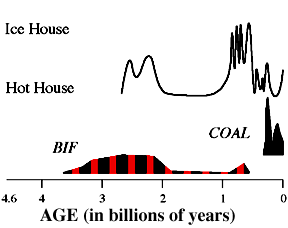 I. IN THE BEGINNING THERE WAS A SINGULARITY.
I. IN THE BEGINNING THERE WAS A SINGULARITY.No time or space, our present physical laws did not apply.
Earth's First 3.7 Billion Years and the Beginnings of Dinosaurs NOTE: THIS PAGE IS UNDER CONSTRUCTION AND BEING MODIFIED ALL TODAY AS YOU WATCH IT!
 I. IN THE BEGINNING THERE WAS A SINGULARITY.
I. IN THE BEGINNING THERE WAS A SINGULARITY.
No time or space, our present physical laws did not apply.
At first there was just Hydrogen. The Hydrogen condensed into billions of local large balls of superdense Hydrogen in which fusion reactions forming Helium began and stars were born. Other elements up to the atomic wieght of Iron were produced in these stars.
About 5 to 6 billion years ago. One of these stars began to run out of Hydrogen fuel. It expanded to a red giant and then collaped on itself and exploded in a supernova. In this supernova, like billions that have occured elsewhere in our Universe all of the other elements were created.
 II. The mass of new matter again collaped into a disk shape mass of dust and gas (a). The center became superheated and formed a new star, our sun (b). From this disk of matter the planets began to condense (c), according the widely supported nebular hypothesis of Immanuel Kant and Pierre-Simon Laplace. The two strongest points in favor of this idea are: 1) that the disk began by rotating in one direction and the rotation of all of the planets around the sun follows the original disk; and 2) that because the disk flattened out as time progresses, all of the orbits of the planets (except Pluto) lie more or less in the same plane (d). Pluto is possibly a captured giant asteroid.
II. The mass of new matter again collaped into a disk shape mass of dust and gas (a). The center became superheated and formed a new star, our sun (b). From this disk of matter the planets began to condense (c), according the widely supported nebular hypothesis of Immanuel Kant and Pierre-Simon Laplace. The two strongest points in favor of this idea are: 1) that the disk began by rotating in one direction and the rotation of all of the planets around the sun follows the original disk; and 2) that because the disk flattened out as time progresses, all of the orbits of the planets (except Pluto) lie more or less in the same plane (d). Pluto is possibly a captured giant asteroid.
 III. The earth condensed in four basic steps. 1) It began to accrete from the nebular cloud as particles smashed into each other forming so called planetesimals. These in turn collided with each other and as their mass grew began to gather material from the nebular disk. 2) As the mass of the Earth grew so did it gravitational force and the Earth began to compress itself into a smaller and denser body. This happened about 4.5 billion years ago.
III. The earth condensed in four basic steps. 1) It began to accrete from the nebular cloud as particles smashed into each other forming so called planetesimals. These in turn collided with each other and as their mass grew began to gather material from the nebular disk. 2) As the mass of the Earth grew so did it gravitational force and the Earth began to compress itself into a smaller and denser body. This happened about 4.5 billion years ago.
3) In the third step the compression itself began to heat the interior of the Earth as did heat generated by radioactive decay. The interior of the earth begins to melt. Because iron is the heaviest of the common elements that make up the Earth, as the Earth began to melt droplets of melted iron began to sink towards the center of the earth, where they condensed. 4) Proceeding slowly at first it sped up to catastrophic proportions ‹ hence it is called the iron catastrophe. Note that 3 and 4 to the right are cross sections.
It was the iron catastrophe that set up the over all structure of the Earth.
All during this time the earth was still being bombarded by asteroids and comets, a process that still occurs but at a much lower (although still significant!) rate.
At some point however, the Moon formed. Exactly how that happened is a major subject of debate. One theory claims that the Moon is a tiny planet captured by the Earth's gravity. The other is that the moon was literally splashed out of the Earth by the impact of a Mars-sized planet. The latter theory is favored now because it explains some odd, but important features of the Earth's and Moon's chemical composition.IV. However, the crust finally solidified by about 3.7 billion years ago. Gasses pouring out of volcanoes and fissures, along with lava began to accumulate, perhaps added to by the impact of a few giant comets (which are mostly gas).The Earth was reborn during the iron catastrophe and maybe again by the formation of the moon. Any trace of surface structure was wiped out by the melting.
The gases that accumulated were those we still find coming out of volcanoes.This atmophere would be quicly fatal to us.Water vapor (H2O)These gases combined to form:
Hydrogen chloride (HCl)
Carbon Monoxide (CO)
Carbon Dioxide (CO2)
Nitrogen (N2)Methane (CH4)
Ammonia (NH4)
Hydrogen Cyanide (HCN)
V. As the crust cooled water would condence and accumlate as oceans. This happended very soon after the crust solidified.
VI. LIFE EVOLVES
The origin of life is shrouded in mystery. But there have been significant steps towards some understanding.
Making many complex organic molecules is the first step, but apparently not a difficult one.
This was shown in the famous Miller-Urey experiments done in the 1950's.The two essential elements of Life are that the system needs to be able to replicate and it needs to be separated from its surroundings - it needs and identity.Stanley Miller and Harold Urey were a graduate student/professor team here at Columbia. They planned to set up an experiment to see how complex organic molecules could be produced. Basically they mixed together gasses that they though the primitive Earth would have in a jar and zapped the gases with an electrical spark. Viola! Complex organic goo collected at the bottom of the jar. Included were amino acids, the building blocks of proteins. But no life.
Such experiments have been repeated many times and it is clear that it is easy to make many complex organic compounds but none of these simple experiments produced even the basics of life.
Here is a link to a some new experimental (and highly technical) work on creating replication.
Simple self replicating molecules developed in this so called primordial soup of organic matter in water.By 3.5 billion years ago there was life, certainly with the full compliment of the basic genetic system - with DNA and RNA. (Click here if you want a basic outline of DNA and RNA) (Click here if you want lots of detail)Clay or some mineral may have acted as an organizing substrate.
But once there was replication, there would be occasional errors and hence, there could be evolution.
There were cells encapsulate in membranes so their internal working were isolated from their surroundings.
Their was photosynthesis with the production of O2.
Evidence for this are stromatolites and silicified microorganisms.At first all sediments gray - reduced iron. Great gold deposits such as the Witswatersrand in river deposits associated with iron sulfides. This is not possible in O2-rich atmosphere.
Then about 2.6 we get the first red Banded Iron Formations (BIF's). Red and gray zones of oxidized iron layers of silica.
Responsible for worlds most important iron deposits.Formation probably due to cycles of photosynthesis then biological crash. Soluble iron comes out of solution in presence of O2 when photosynthetic microbes doing well. When they perhaps seasonally died off, the silica was deposited.
 As soluble iron started to get used up, O2 began to build up in atmosphere, CO2 dropped.
As soluble iron started to get used up, O2 began to build up in atmosphere, CO2 dropped.Earth went into oscillating glacial ages - even at equator. The basic set up of weathering as we know it was probably set up at this time.
Experiments show that even algal scum on crushed rock enhances weathering by several times to several orders of magnitude.
VII. UNTIL ABOUT 1.9 BILLION YEARS AGO WE HAVE EVIDENCE ONLY OF THE SIMPLEST KINDS OF LIFE - THE PROKARYOTES - BACTERIA AND BLUE GREEN ALGAE
But at about 1.9 billion years we start to see fossils of much larger cells. These cells belong to the Eukaryotes - of which we are members.
Eukaryotic cells are symbiotic colonies of prokaryotes many of the symbionts called organelles. O2 handled by Mitochondria, chloroplasts handle photosynthesis. These organelles independently replicate with their own genome DNA sequences in a circular strands, as in bacteria. Several other kinds of organelles are similar.The relatively independent lives and separate genetic systems of these organelles led Lynn Margulis to develop the "organelle theory" (a form of which was first proposed by Mereschkowsky in 1905) in which different groups of prokaryotes became endosymbionts in other cells.
About 650 million years ago (0.65 billion) the first apparently multicellular forms are present. These are called the Ediacara assemblages. They all seem to be elaborations of forms with large surface areas, all living in shallow relatively high energy environments - often in red beds.
Perhaps they needed greater surface are of absorb O2 in less than modern atmospheric amounts.Key to multicellular animals seems to the so called homeotic genes. Very odd newly discovered. Seem to be involved with headness, tailness, very general properties. So head structures homologous between flies and humans. So are eyes, even though a fly's eye is compound ours are not and our common ancestor had no eyes at all. The instructions for eyeness is evidently homologous. This sophistication is probably why multicellularity took so long.
About the same time (650 million years ago) the first burrow appear.
This record the evolution of the coelom. A sac that contains the organs. We have one. Allow for hydrostatic support of body so it can push through mud etc.Allowed for proliferation of larger forms.
Now animals and plants could modify the physical structure of their environment not just its chemistry - and eat each other.
VIII. At the beginning of the Cambrian 540 million years ago multicellular animal life explodes!
This shows up with the appearance of skeletal hard parts.
All major phyla present by the End of the Cambrian.
1. Life is active chemical system separated from its surroundings and out of chemical equilibrium with its surroundings. Chemical equilibrium =
death.
2. Life reproduces with heredity
3. There is variation in that heredity
4. There is evolution of populations, adaptation, and innovation
5. There are species that are reproductively isolated from other species and on their own
evolutionary trajectories
6. Species make societies of kin and parasitic to symbiotic relationships with other species.